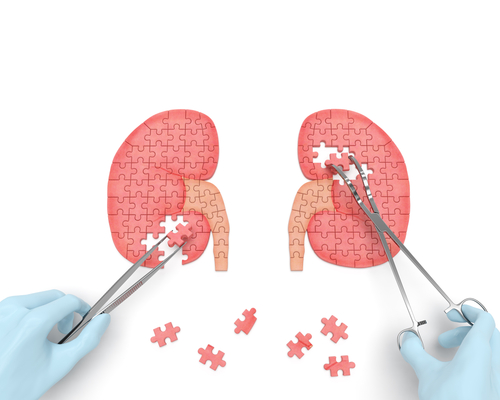Alport Patient Shows Improvement After Receiving Kidney from Father Later Found to have ADAS, Study Says

A patient with Alport syndrome (AS) showed clinical improvement years after receiving a transplant of a kidney from his father, even though subsequent genetic analysis found that the patient has autosomal recessive AS (ARAS) while his father has the autosomal dominant (ADAS) form of the condition.
The study, “Retrospective genetic analysis illustrates the spectrum of autosomal Alport syndrome in a case of living-related donor kidney transplantation,” appeared in the journal BMC Nephrology.
The use of next-generation genetic sequencing has enabled the identification of a larger proportion of patients with the autosomal types of AS — those with a mutation in the COL4A3 or COL4A4 genes found in chromosome 2.
The risk of end-stage renal disease (ESRD) is higher in patients with ARAS (caused when both copies of the same gene are mutated) than with ADAS (caused by one mutated gene copy). However, prognosis can be difficult to establish in such patients and reports of kidney transplantation from relatives are scarce.
A team from Germany described the case of a 26-year-old man who had been experiencing microhematuria and proteinuria — blood and abnormal amounts of protein in urine — since he was 3. A renal biopsy done 10 years later found alterations in the glomerular basement membrane (GBM, which has a key role in the kidney’s filtration barrier) consistent with a diagnosis of AS.
Extra-renal manifestations included bilateral hearing loss at high frequencies, but no ocular lesions. At age 24, the patient developed ESRD and required hemodialysis followed by peritoneal dialysis over 12 months.
As the family history was negative, the case was considered X-linked, and the patient’s father was evaluated as a potential kidney donor. Given that no changes were found on kidney biopsy, and laboratory results and blood pressure were normal, the father was accepted as a donor.
A standard immunosuppressive protocol was then followed, with no relevant complications during surgery and the postoperative period. Also, initial graft (transplant) function was satisfactory, and the donor and recipient were discharged from the hospital.
Two to three years later, the patient won two gold medals, two silver medals, and a bronze medal at the World Transplant Games and the European Transplant and Dialysis Sports Championship, which demonstrates his successful clinical outcome.
Seven years after transplantation, both donor and recipient showed moderate renal function at kidney disease stage 3a. The father showed stable estimated glomerular filtration rate (eGFR; a kidney function marker) at 60 ml/min/1.73 m2 with modest microalbuminuria. The patient showed stable baseline eGFR at 48 ml/min/1.73 m2, though with persistent proteinuria due to chronic transplant glomerulopathy — disease of the kidneys’ glomeruli.
A genetic analysis found compound heterozygous variants — two different mutated gene copies — in the COL4A3 gene of the patient, one inherited from the father (c.1909G > A) and the other from the mother (c.4421 T > C). Both parents showed hearing impairments in their 60s. The 38-year-old brother also carried the paternal variant, but did not have signs of renal dysfunction, or any ocular or hearing abnormalities.
This paternal variant had not been described, and subsequent analysis deemed it as “likely pathogenic.” The maternal mutation had been reported in AS, and — given its relatively high allele frequency in the general population (0.49%) — was classified as “variant of uncertain significance.”
“In retrospect, we have to admit that if we had known the father to be carrier of a novel, likely pathogenic COL4A3 variant at the time of evaluation, we would not have approved kidney donation for risks of unpredictable outcomes,” the team said. “Luckily, selection of the father as donor in this transplant still resulted in a satisfactory clinical course.”
An electron microscopy re-evaluation of the father’s pre-transplantation kidney biopsy revealed mild GBM-thinning, but also partial COL4A5 deficits, which supported a diagnosis of non-progressive thin basement membrane nephropathy with light ADAS. In contrast, the patient showed severe GBM-alterations and marked COL4A5 deficits in line with progressive renal manifestation of ARAS.
“In summary, living-related donor transplantation may be successful in autosomal AS, provided that thorough clinical and genetic evaluation of potential donors is performed. However, unrelated kidney transplantation should be given priority,” the researchers wrote.
“Individual genetic variant interpretation is an important component of personalized donor assessment and will help to better predict genetic risk in the future,” they added.







Leave a comment
Fill in the required fields to post. Your email address will not be published.